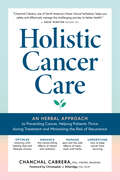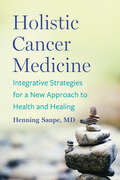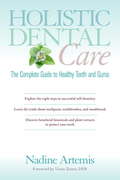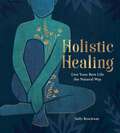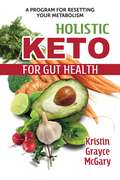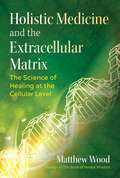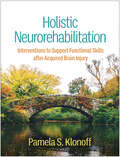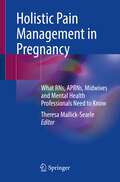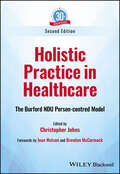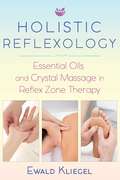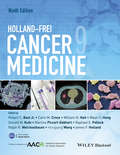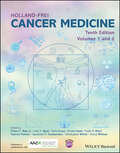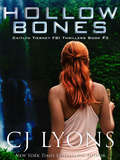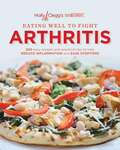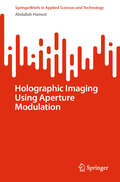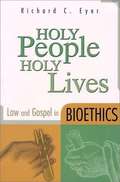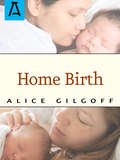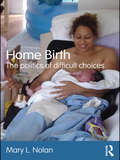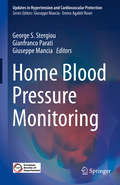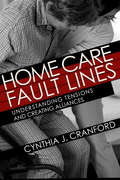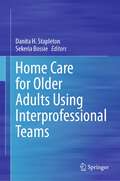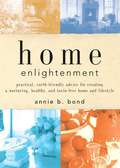- Table View
- List View
Holistic Cancer Care: An Herbal Approach to Preventing Cancer, Helping Patients Thrive during Treatment, and Minimizing the Risk of Recurrence
by Chanchal CabreraA medical herbalist with a specialty in integrative oncology provides an in-depth guide to practical, solution-focused strategies for using herbal medicines and other natural therapies. Patients facing a cancer diagnosis often feel at the mercy of an illness they don't understand and in the hands of doctors offering treatments that focus on the cancer, instead of on the patient. In Holistic Cancer Care, Chanchal Cabrera, a consulting medical herbalist with more than 20 years specializing in holistic oncology, provides an in-depth guide to using herb-based therapies in conjunction with conventional treatments. Putting the patient front and center, holistic therapies can help boost the immune system, which can slow the spread of certain cancers and, in some cases, even enhance the cancer-killing effects of chemotherapy. Herbal medicine and other therapies also offer effective ways of dealing with the side effects of chemotherapy and radiation. Drawing from decades of clinical experience helping patients recover from cancer, Cabrera provides a wealth of safe, well-researched information, including specific herbal formulas, important discussions about dosing and safety, detox protocols, recommendations for nutritional supplements, simple recipes for nourishing meals, and patient case histories that demonstrate the power of the strategies she recommends. This publication conforms to the EPUB Accessibility specification at WCAG 2.0 Level AA.
Holistic Cancer Medicine: Integrative Strategies for a New Approach to Health and Healing
by Henning Saupe*As Seen on Chris Beat CancerA groundbreaking, comprehensive guide on managing, treating, and preventing cancer.*Introducing: The Holistic Model of the Twelve Vital Fields*It&’s a sad truth of our times that one in three people will experience cancer in their lifetime. By 2040, the probability will rise to one in two. As a comprehensive guide on natural treatment, Holistic Cancer Medicine is essential reading for every cancer patient—from newly diagnosed to late stage. For those seeking to prevent the disease, it also provides key information on how to reduce your risks.As the founder and director of Germany&’s leading complementary cancer clinic, Dr. Henning Saupe offers Holistic Cancer Medicine as the culmination of twenty-five years of experience treating the disease. Dr. Saupe&’s unique vantage and insight complements standard treatment models with less burdensome, less invasive, and more natural methods. His program focuses on how those affected by cancer can carry out treatment to cure or control the disease while maintaining a high quality of life.Other topics include:The revolutionary Holistic Model of the Twelve Vital FieldsThe dynamic interplay between nutrition, circulation, the microbiome, mitochondrial health, acid-base balance, and chronic infections, and moreSpecific tumor-killing methods, such as insulin potentiation therapy (IPT), photodynamic therapy (PDT), local and whole-body hyperthermia, and pulsating electromagnetic frequency therapy (PEMF)Inner-life training (ILT) and affirmations for both physical and emotional painTools for those accompanying relatives, friends, or colleagues through the stages of cancerAnd much moreHolistic Cancer Medicine is a groundbreaking book for a critical time of life with an essential and compassionate message: that a diagnosis of cancer and living a vibrant life are not mutually exclusive.&“Dr. Saupe&’s comprehensive new book shows that there is so much a person can do to treat and prevent cancer in addition to conventional medicine. If you want to gain a thorough understanding of cancer cells and the immune system, I highly recommend Holistic Cancer Medicine.&”—Kelly A. Turner, PhD, New York Times bestselling author of Radical Hope and Radical Remission
Holistic Dental Care: The Complete Guide to Healthy Teeth and Gums
by Nadine Artemis Victor ZeinesA comprehensive guide to natural, do-it-yourself oral care, Holistic Dental Care introduces simple, at-home dental procedures that anyone can do. Highlighted with fifty-three full-color photos and illustrations, this book offers dental self-care strategies and practices that get to the core of the problems in our mouths--preventing issues from taking root and gently restoring dental health. Based on a "whole body approach" to oral care, Holistic Dental Care addresses the limits of the traditional approach that treats only the symptoms and not the source of body imbalances. Taking readers on a tour of the ecology of the mouth, dental health expert and author Nadine Artemis describes the physiology of the teeth and the sources of bacteria and decay. Revealing the truth about the artificial chemicals in many toothpastes and mouthwashes, Artemis also discusses the harmful effects of mercury fillings and the much safer ceramic filling options that are available. Covering topics that include healthy nutrition, oral care for children, and the benefits of botanical substances and plant extracts for maintaining oral health, Artemis introduces a comprehensive eight-step self-dentistry protocol that offers an effective way to prevent decay, illness, acidic saliva, plaque build-up, gum bleeding, inflammation, and more.
Holistic Healing: Live Your Best Life the Natural Way
by Sally BrockwayOpen your mind to a new, more wholesome way of living. Soothe away everyday stress with this beautifully presented collection of practical advice for achieving optimum health and well-being. Quieten your mind with meditation and yoga, find balance through plant-based home-made remedies, and be kind to yourself with a curated self-care routine.
Holistic Healing: Live Your Best Life the Natural Way
by Sally BrockwayOpen your mind to a new, more wholesome way of living. Soothe away everyday stress with this beautifully presented collection of practical advice for achieving optimum health and well-being. Quieten your mind with meditation and yoga, find balance through plant-based home-made remedies, and be kind to yourself with a curated self-care routine.
Holistic Keto for Gut Health: A Program for Resetting Your Metabolism
by Kristin Grayce McGaryA step-by-step guide to addressing autoimmune and other health challenges through a healthy digestive system • Offers a therapeutic ketogenic gut repair program that differs from mainstream ketogenic diets because it excludes inflammatory foods that cause gut damage, immune dysfunction, accelerated aging, and tissue damage • Provides a science-based explanation for why almost everyone has some degree of gut damage and how this impacts your immune function and health issues • Details the right kind of lab tests needed for proper diagnosis of food sensitivities and autoimmune disorders • Includes dozens of delicious, easy-to-prepare recipes that keep you feeling satisfied Do you feel exhausted? Experience foggy thinking and mysterious symptoms that come and go--symptoms your doctors can&’t figure out and yet they keep prescribing more and more medications? Do you have headaches, congestion, or allergies? Do you suffer from joint pain, sleep challenges, hormone imbalances, skin problems such as eczema and psoriasis, thyroid dysfunction, or any other autoimmune disorder? Holistic healthcare expert Kristin Grayce McGary reveals that the answer to resolving your health challenges may lie in comprehensive gut repair. Combining the best gut-healthy elements of primal, paleo, and ketogenic nutritional plans, McGary offers a one-of-a-kind approach for optimal digestive health. Unlike the traditional keto diet, which contains inflammatory foods, McGary&’s science-based, functional ketogenic program emphasizes a holistic nutritional and lifestyle plan to repair your gut while avoiding the dangers of gluten, dairy, soy, starches, sugars, chemicals, and pesticides. She reveals how nearly everyone has some degree of gut damage and explains how this impacts your immune function, energy levels, and many health issues. Drawing on her extensive knowledge of blood chemistry analysis and how to halt and prevent autoimmune challenges, McGary details the right kind of lab tests needed for proper diagnosis of food sensitivities and autoimmune disorders and where to get them--helping readers overcome the ongoing misdiagnosis that millions with gut problems and autoimmunity symptoms suffer. Additionally, she provides a thorough list of supplements and foods for gut healing, delicious recipes that leave you feeling satisfied and strong, and contemplative exercises to help you dive even deeper into healing. Blending humor, scientific information, client examples, and personal stories with unique insights into achieving optimal health, McGary gives you the practical tools necessary to achieve a healthy digestive system, sustainable well-being, and vibrant longevity.
Holistic Medicine and the Extracellular Matrix: The Science of Healing at the Cellular Level
by Matthew Wood• Examines the function of the extracellular matrix, the inner ocean that unifies all our cells and controls them in a coordinated and integrated fashion • Explores how the extracellular matrix builds and repairs itself and how holistic therapy can be applied based on this knowledge • Introduces new and old holistic and herbal protocols for treatment of the matrix The cells in our bodies are not independent units. They do not control their own feeding, elimination, migration, or reproduction; they are controlled by signals from the extracellular matrix (ECM) that surrounds them. This all-encompassing inner ocean unifies all our cells and controls them in a coordinated and integrated fashion. Revealing the stunning implications of the extracellular matrix, Matthew Wood shows how it clearly explains the actions and efficacy of holistic therapies. He explores the groundbreaking research of Alfred Pischinger, who discovered the ECM in 1975, as well as the role of the matrix in transmitting and enacting the genetic code, including the roles of the mitochondria, the nucleus, and ribosomes. Wood explains how modern drugs, directed at specific receptors on the cell membrane, interfere with bodily self-regulation. He details how holistic therapies modify the environment of the cell and strengthen the whole, bringing the body back to homeostasis and consequently offering true healing.
Holistic Neurorehabilitation: Interventions to Support Functional Skills after Acquired Brain Injury
by Pamela S. KlonoffHighly practical and comprehensive, this book provides a multimodal framework for helping patients with acquired brain injuries to identify and achieve meaningful functional goals in the home and community. In a convenient large-size format, the volume features rich case examples and interdisciplinary tools and strategies. Post-acute cognitive, physical, communication, emotional, vocational, interpersonal, family, and quality-of-life domains are all addressed, using state-of-the-art restorative and compensatory approaches. Coverage includes both individual and group therapies. Fifty reproducible forms and handouts can be photocopied from the book or downloaded from the companion website. The website also features a supplemental chapter on efficacy and outcomes research in neurorehabilitation, appendices with helpful resources, color versions of selected figures, and more.
Holistic Pain Management in Pregnancy: What RNs, APRNs, Midwives and Mental Health Professionals Need to Know
by Theresa Mallick-SearleThis book presents a patient centric, holistic view and management strategy for registered nurses, advanced practice nurses and midwives to care for the pregnant female, including considerations in pregnancy planning. There is a significant gap in information about holistic care and nursing considerations of the pregnant female with regards to pain management, which this book fills. It develops on the preparation before pregnancy, as nutrition or exercise, on behavioural management of pain with the impact of anxiety and different therapies. The book examines the musculoskeletal pain, the headache and fibromyalgia occurring during pregnancy. It also informs on the nutraceuticals in pregnancy, the use of opioids and of nerve blocks. This book finally explores complementary treatments during pregnancy.Case-studies are presented for improved understanding and to provide a real-world perspective. This book, written by nursing and psychology experts in their fields of specialty practice, will appeal to nurses and midwives working with pregnant women or planning to have a baby.
Holistic Practice in Healthcare: The Burford NDU Person-centred Model
by Christopher JohnsHolistic Practice in Healthcare Make holistic and person-centred practice a lived reality in any practice setting, improving patient care through application of the Burford NDU model Holistic Practice in Healthcare is the 30th anniversary review and development of a holistic model that enables practitioners, organisations, and educators to unleash their therapeutic potential and deliver patient-centred care. This model gives structure and direction to practice in a range of practice settings, and includes information on: Systems for tuning practitioners into the holistic vision, communicating holistic practice, and organising delivery of holistic practiceSystems for enabling practitioners to realise holistic practice and to live and ensure holistic qualityReflections from primary and associate nurses on using this holistic model at Burford and the Oxford Community Hospital, and on applying the model in an acute medical unit, community setting, and hospice settingEstablishing a learning culture to support holistic practice through leadershipContributions from professors Jean Watson and Brendan McCormack, highlighting the essential significance of holistic practice in the modern world Providing key insight from practitioners of the Burford NDU model, Holistic Practice in Healthcare is an essential resource for all nurses and healthcare professionals looking to become holistic practitioners.
Holistic Reflexology: Essential Oils and Crystal Massage in Reflex Zone Therapy
by Ewald KliegelA guide to reflexology treatments combined with complementary therapies to restore energetic balance, relieve pain, and support healing • Provides more than 30 full-color maps of reflex zone systems from head to toe, including the ears, mouth, tongue, fingernails, and torso • Explains how to incorporate supportive therapies such as essential oils, crystal wand massage, and visualization to maximize healing • Examines the history and evolution of reflexology, revealing both its Eastern and Western roots, as well as recent international advancements Expanding the practice of reflexology beyond the feet and hands, Ewald Kliegel illustrates how to precisely and quickly treat different emotional and physical disorders with an integrated combination of reflexology and complementary therapies. Applying the fundamental principles of reflexology to the entire body, he provides more than 30 full-color maps of reflex zones from head to toe, including reflex zone systems of the ears, mouth, tongue, fingernails, and torso. The author details reflexology techniques for each reflex zone and discusses how to incorporate essential oils and gemstones during active touch and reflexology sessions, including the benefits of crystal massage for post-stroke recovery. Drawing on international advancements in reflexology, including the work of craniosacral reflexologist Martine Faure-Alderson, Russian researcher Alexander Kachan, Chinese biologist Zhang Yingquing, and Korean physician Tae Woo Yoo, Kliegel examines how to integrate Yin-Yang massage strokes, metacarpal reflexology techniques, Korean Hand treatments, and craniosacral massage principles into reflexology treatments to restore energetic balance, relieve pain, and support healing. He outlines specific treatment protocols, including holistic reflexology treatments for headache, digestive problems, and back pain. Providing step-by-step instructions for diagnostic testing, he also outlines supportive approaches such as visualization to balance the energies of the body and an active meditation to troubleshoot congested locales in the body. Examining the history and evolution of reflexology, the author reveals not only the ancient Eastern medical practices that played a role in reflexology’s genesis, but also its ancient European roots. Providing a truly holistic and integrative approach to reflexology, Kliegel reveals many different hands-on paths to healing that embrace the energetic interconnections of mind and body.
Holland-Frei Cancer Medicine
by Waun Ki Hong Raphael E. Pollock Carlo M. Croce Donald W. Kufe Hongyang Wang James F. Holland Martine Piccart-Gebhart Ralph R. Weichselbaum Robert C. Bast Jr. William N. HaitHolland-Frei Cancer Medicine, Ninth Edition, offers a balanced view of the most current knowledge of cancer science and clinical oncology practice. This all-new edition is the consummate reference source for medical oncologists, radiation oncologists, internists, surgical oncologists, and others who treat cancer patients. A translational perspective throughout, integrating cancer biology with cancer management providing an in depth understanding of the disease An emphasis on multidisciplinary, research-driven patient care to improve outcomes and optimal use of all appropriate therapies Cutting-edge coverage of personalized cancer care, including molecular diagnostics and therapeutics Concise, readable, clinically relevant text with algorithms, guidelines and insight into the use of both conventional and novel drugs Includes free access to the Wiley Digital Edition providing search across the book, the full reference list with web links, illustrations and photographs, and post-publication updates
Holland-Frei Cancer Medicine
by Robert C. Bast JrHOLLAND-FREI CANCER MEDICINE The latest edition of the gold-standard in cancer science and clinical oncology references In the newly revised Tenth Edition of Holland-Frei Cancer Medicine, a team of distinguished researchers and practitioners delivers a comprehensive and up-to-date discussion of cancer science and clinical oncology practice. The book contains timely and indispensable information on epidemiology, etiology, cancer biology, immunology, prevention, screening, clinical presentation, pathology, imaging, and therapy. Grounded in a fundamental understanding of cancer biology, Holland-Frei Cancer Medicine combines scientific principles with clinical practice. It contains hundreds of full-color illustrations and photographs, tables, graphs, and algorithms that complement and enhance the complex topics discussed within the book. This book is an invaluable clinical tool that provides readers with overview boxes, additional references, and other pedagogic features designed to make the content easy to access and comprehend. Readers will also find: A translational and integrated approach throughout the book that combines cancer biology with cancer management A strong emphasis on multidisciplinary, research-driven patient care that improves outcomes and allows for the optimal use of all clinically appropriate therapies Discussions of the most current personalized cancer care, including molecular diagnostics and therapeutics Perfect for medical oncologists, radiation oncologists, and internists, Holland-Frei Cancer Medicine, Tenth Edition will also earn a place in the libraries of allied health professionals involved in the treatment of cancer patients. This book is published in collaboration with the American Association for Cancer Research: https://www.aacr.org/
Hollow Bones: Caitlyn Tierney Fbi Thrillers Book 3 (Caitlyn Tierney FBI Thrillers #3)
by CJ LyonsIn this romantic suspense thriller by the bestselling author of Black Sheep, an FBI agent searches for a missing college student in a Guatemalan jungle.From the ancient mysteries of a Mayan temple to the sinister secrets of modern medicine, FBI agent Caitlyn Tierney uncovers crimes that have been buried far too long and far too deep . . .It’s the kind of case that chills Caitlyn to the bone. Missing person. College student. Beloved daughter of a world leader in biotech. Last seen on a spring break cruise.No witnesses. No motives. Only one possible lead: reports of a stranger who may have lured the young archeology student off the ship and into the jungles of Guatemala.When Caitlyn follows the girl’s scant trail—more a hunch than a clue—the trail takes a surprising turn into the very heart of darkness.Praise for Blind Faith“This story is so fast-paced with so many mesmerizing characters, “fantastic” is not high enough praise. Lyons proves once again that she is a master of suspense.” —RT Book Reviews (Top Pick, 4 ½ Stars)“A haunting, intense, and multi-layered thriller that adroitly combines an action-packed plot and delicately drawn relatable characters.” —Night Owl Reviews“This stand-alone story starts slowly like an extreme roller coaster, but once it crests its first peak, it rolls and twists and turns with non-stop page-turning adventure. . . . With its multi-layered secrets and betrayals, readers who love romantic suspense are sure to find this a compelling read!” —Fresh Fiction
Holly Clegg's Trim and Terrific Eating Well to Help Fight Arthritis: 200 Easy Recipes and Practical Tips to Help Reduce Inflammation and Ease Symptoms
by Holly CleggCan certain foods help ease arthritis symptoms? With over 100 types of arthritis that each affects the body differently, I believe your diet can make a difference in the way you feel. This practical cookbook is designed to focus on foods to help minimize the effects of arthritis with easy-to-follow, mainstream, time-friendly and super-satisfying recipes. Each chapter gives a straightforward approach with guidance, tips and delicious recipes for a healthy kitchen that will help you eat well to fight arthritis. Eating Well to Fight Arthritis offers: -200 easy recipes -Nutritional and diabetic information with each recipe -Highlights Diabetic Friendly recipes within American Diabetes Association guidelines -Highlights Gluten-Free -Freezer Friendly, and Vegetarian recipes
Holographic Imaging Using Aperture Modulation (SpringerBriefs in Applied Sciences and Technology)
by Abdallah HamedThis book highlights the formation of holographic images using modulated apertures across eleven comprehensive chapters. It begins with a summary of basic Fourier transformations used to compute diffraction patterns of well-known objects. The fundamentals of holography are outlined, followed by an investigation of Fourier holographic images obtained using argon plasma. This book also explores Fourier holographic images using modulated Hamming apertures and discusses the use of scanning holography with linear and quadratic apertures. Advanced topics include the processing and segmentation of cancerous mammographic images using improved Fourier holograms, and the detailed study of Fourier holographic imaging of modulated apertures. The recognition of colored objects and the computation of the point spread function (PSF) using operator algebra in Gaussian beam illumination are also covered. This book concludes with a discussion on pattern recognition and information processing. This book serves as an essential resource for researchers and students interested in the advanced techniques and applications of holographic imaging.
Holy People, Holy Lives: Law and Gospel in Bioethics
by Richard C. EyerThis book highlights the issues of technology and ethics in medical decision-making, seeing God's story, revealed in Law and Gospel, as the foundation for Christian living.
Home Before Morning: The Story of an Army Nurse in Vietnam
by Lynda Van Devanter Christopher MorganLynda Van Devanter was the girl next door, the cheerleader who went to Catholic schools, enjoyed sports, and got along well with her four sisters and parents. After high school she attended nursing school and then did something that would shatter her secure world for the rest of her life: in 1969, she joined the army and was shipped to Vietnam. When she arrived in Vietnam her idealistic view of the war vanished quickly. She worked long and arduous hours in cramped, ill-equipped, understaffed operating rooms. She saw friends die. Witnessing a war close-up, operating on soldiers and civilians whose injuries were catastrophic, she found the very foundations of her thinking changing daily. <P><P> After one traumatic year, she came home, a Vietnam veteran. Coming home was nearly as devastating as the time she spent in Asia. Nothing was the same ― including Lynda herself. Viewed by many as a murderer instead of a healer, she felt isolated and angry. The anger turned to depression; like many other Vietnam veterans she suffered from delayed stress syndrome. Working in hospitals brought back chilling scenes of hopelessly wounded soldiers. A marriage ended in divorce. The war that was fought physically halfway around the world had become a personal, internal battle.<P> Home before Morning is the story of a woman whose courage, stamina, and personal history make this a compelling autobiography. It is also the saga of others who went to war to aid the wounded and came back wounded ― physically and emotionally ― themselves. And, it is the true story of one person's triumphs: her understanding of, and coming to terms with, her destiny.
Home Birth
by Alice GilgoffFor women who believe that childbirth is a normal event, and that hospitals are places to treat illness, home birth with a licensed professional midwife is a safe and viable option. Unlike the rest of the world where home birth and midwifery are the norm, Western society has captured the traditional childbirth model and recreated it as a high-tech pathological event fraught with dangerous interventions. Yet, the United States continues to rank 20th or worse in United Nations statistics of maternal and infant mortality. When this book was first published in 1978, the convergence of the back-to-nature and feminist movements--and the rise of consumer advocacy in health care--contributed to a growing home birth movement. Today, a 40% cesarean rate and the universal acceptance of stay-in-bed electronic fetal monitoring, an unproven technology, are just two of the common hospital occurrences that keep some women at home for childbirth. Midwife comes from the German word that translates as "with woman." Research has shown that the close observation of an educated and caring woman makes birth complications predictable or preventable. Studies published in medical literature have documented that the care of educated, professional midwives is equal to or better than that of medical doctors, whether the birth takes place in the home or hospital. Home Birth reports on this research, as well as personal, practical stories of real childbearing families. The book reviews typical birth practices and gives advice on preparing both the family and the home for the event. There is also a chapter on preparing for hospital birth, should a transport in labor become necessary.
Home Birth: The Politics of Difficult Choices
by Mary L. NolanThe rhetoric of choice is much used in UK health policy and home birth is one of the three options that women are entitled to choose between when deciding where to have their baby. However, many women making this choice run into considerable opposition from the maternity service. Home Birth: the politics of difficult choices focuses on the experiences of women whose choices were opposed by health professionals during their pregnancy journey. It confronts why and how women are being denied home birth and raises some challenging issues for current midwifery practice. Using ten women’s narratives, this important volume explores why women might want to give birth at home and considers ideas of risk and informed choice in pregnancy and birth. The book includes chapters on communication and language; fear and stress; advocacy and autonomy; fathers’ experience of contested place of birth and free birthing. Pointers to best practice are presented whilst the text incorporates women’s narratives throughout, making this a practical and relevant read for midwifery students as well as practising midwives and childbirth educators, all of whom have a duty to make home birth a real option for women.
Home Blood Pressure Monitoring (Updates in Hypertension and Cardiovascular Protection)
by Giuseppe Mancia Gianfranco Parati George S. StergiouHypertension remains a leading cause of disability and death worldwide. Self-monitoring of blood pressure by patients at home is currently recommended as a valuable tool for the diagnosis and management of hypertension. Unfortunately, in clinical practice, home blood pressure monitoring is often inadequately implemented, mostly due to the use of inaccurate devices and inappropriate methodologies. Thus, the potential of the method to improve the management of hypertension and cardiovascular disease prevention has not yet been exhausted.This volume presents the available evidence on home blood pressure monitoring, discusses its strengths and limitations, and presents strategies for its optimal implementation in clinical practice. Written by distinguished international experts, it offers a complete source of information and guide for practitioners and researchers dealing with the management of hypertension.
Home Care Fault Lines: Understanding Tensions and Creating Alliances (The Culture and Politics of Health Care Work)
by Cynthia J. CranfordIn this revealing look at home care, Cynthia J. Cranford illustrates how elderly and disabled people and the immigrant women workers who assist them in daily activities develop meaningful relationships even when their different ages, abilities, races, nationalities, and socioeconomic backgrounds generate tension. As Cranford shows, workers can experience devaluation within racialized and gendered class hierarchies, which shapes their pursuit of security. Cranford analyzes the tensions, alliances, and compromises between security for workers and flexibility for elderly and disabled people, and she argues that workers and recipients negotiate flexibility and security within intersecting inequalities in varying ways depending on multiple interacting dynamics. What comes through from Cranford's analysis is the need for deeply democratic alliances across multiple axes of inequality. To support both flexible care and secure work, she argues for an intimate community unionism that advocates for universal state funding, designs culturally sensitive labor market intermediaries run by workers and recipients to help people find jobs or workers, and addresses everyday tensions in home workplaces.
Home Care for Older Adults Using Interprofessional Teams
by Danita H. Stapleton Sekeria BossieThis textbook fosters a deeper understanding of how home healthcare goals for older adults can be achieved through interprofessional collaboration. The contributors create a context where allied health and healthcare professionals can acquire and exchange knowledge about their diverse disciplines and practices for the betterment of the home care population. The book also reinforces what the COVID-19 pandemic made quite apparent to health institutions and providers: patients can receive adequate and acceptable care within the home setting. The pandemic also highlighted the important role that interprofessionalism can play in attaining desired patient outcomes. Statistics reveal that the population of persons over the age of 65 years is the largest that it has ever been. This volume focuses on older adult patients because caring for these individuals from an interprofessional perspective is now more important than ever. Through the ten chapters of this edited book, the contributors including home care providers offer their perspectives on interprofessional collaboration and the provision of quality home care services. They use the Interprofessional Education Collaborative's (IPEC) four core competencies as a framework for improving the collaborative practice of home health care for older adult patients with complex medical issues. Among the topics covered: Medical Social Work and Case Management Skilled Nursing Physical Therapy Occupational Therapy Behavioral Health Care Other Relevant Home Care Services: Prosthetics and Orthotics, Pharmacy Services, Durable Medical Equipment and Nutritional Services Home Care for Older Adults Using Interprofessional Teams is intended for advanced undergraduate and graduate students in health or allied health programs and can be used as a primary text for interprofessional education courses. The text benefits students, instructors, and faculty who have stakes in obtaining positive health outcomes for older adult patients. Today, more and more programs are requiring the development of interprofessional competencies. This book provides a forum where students can obtain in-depth knowledge of teaming, as well as the roles and functions of various care providers.
Home Enlightenment: Create a Nurturing, Healthy, and Toxin-Free Home
by Annie B. BondA comprehensive guide to creating a toxin-free, environmentally friendly home with an eye toward bringing health and harmony to those living there and those on the earth as a whole. Recent studies show that nearly one-third of American adults, or 63 million consumers, care deeply about health and environmental issues and the realization of human potential through a unity of mind, body, and spirit. Appealing directly to the Lifestyles of Health and Sustainability (LOHAS) market, this informative and practical guide helps readers tend to their living spaces in ecologically sound ways that protect the health and safety of their families and the world around them. From selecting weekly produce to purchasing a water-filtration system, from using a steam cleaner or non-toxic pest controls to adjusting the energy in a home with crystals and aromatherapy, Home Enlightenment examines the environmental impact of choices a consumer makes, and helps readers establish day-to-day practices and a lifestyle that bring healing and natural spirituality into their homes. The author, host of Annie's Healthy Living Network online, is one of the most trusted names in the health and environmental awareness field. Twice poisoned by chemicals as a young adult, Annie has become one of the champions of toxin-free living. Here she shares her story of recovery, renewal, and transformation as a guide for living in a healthier home environment.
